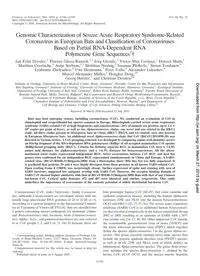
2010 Genomic Characterization of Severe Acute Respiratory Syndrome-Related Coronavirus in European Bats and Classificati PDF
Preview 2010 Genomic Characterization of Severe Acute Respiratory Syndrome-Related Coronavirus in European Bats and Classificati
JOURNAL OF VIROLOGY, Nov. 2010, p. 11336–11349 Vol. 84, No. 21 0022-538X/10/$12.00 doi:10.1128/JVI.00650-10 Copyright © 2010, American Society for Microbiology. All Rights Reserved. Genomic Characterization of Severe Acute Respiratory Syndrome-Related Coronavirus in European Bats and Classification of Coronaviruses Based on Partial RNA-Dependent RNA Polymerase Gene Sequences�† Jan Felix Drexler,1 Florian Gloza-Rausch,1,2 Jo¨rg Glende,3 Victor Max Corman,1 Doreen Muth,1 Matthias Goettsche,4 Antje Seebens,1,2 Matthias Niedrig,5 Susanne Pfefferle,1 Stoian Yordanov,6 Lyubomir Zhelyazkov,6 Uwe Hermanns,7 Peter Vallo,8 Alexander Lukashev,9 Marcel Alexander Mu¨ller,1 Hongkui Deng,10 Georg Herrler,3 and Christian Drosten1* Institute of Virology, University of Bonn Medical Centre, Bonn, Germany1; Noctalis, Centre for Bat Protection and Information, Bad Segeberg, Germany2; Institute of Virology, University of Veterinary Medicine, Hannover, Germany3; Zoological Institute, Department of Ecology, University of Kiel, Kiel, Germany4; Robert Koch Institute, Berlin, Germany5; Forestry Board Directorate of Strandja Natural Park, Malko Tarnovo, Bulgaria6; Bat Conservation and Research Group Mecklenburg-Vorpommern, Rostock, Germany7; Institute of Vertebrate Biology, Academy of Sciences of the Czech Republic, v.v.i., Brno, Czech Republic8; Chumakov Institute of Poliomyelitis and Viral Encephalitides, Moscow, Russia9; and Department of Cell Biology and Genetics, College of Life Sciences, Peking University, Beijing, China10 Received 26 March 2010/Accepted 27 July 2010 Bats may host emerging viruses, including coronaviruses (CoV). We conducted an evaluation of CoV in rhinolophid and vespertilionid bat species common in Europe. Rhinolophids carried severe acute respiratory syndrome (SARS)-related CoV at high frequencies and concentrations (26% of animals are positive; up to 2.4 � 108 copies per gram of feces), as well as two Alphacoronavirus clades, one novel and one related to the HKU2 clade. All three clades present in Miniopterus bats in China (HKU7, HKU8, and 1A related) were also present in European Miniopterus bats. An additional novel Alphacoronavirus clade (bat CoV [BtCoV]/BNM98-30) was detected in Nyctalus leisleri. A CoV grouping criterion was developed by comparing amino acid identities across an 816-bp fragment of the RNA-dependent RNA polymerases (RdRp) of all accepted mammalian CoV species (RdRp-based grouping units [RGU]). Criteria for defining separate RGU in mammalian CoV were a >4.8% amino acid distance for alphacoronaviruses and a >6.3% distance for betacoronaviruses. All the above- mentioned novel clades represented independent RGU. Strict associations between CoV RGU and host bat genera were confirmed for six independent RGU represented simultaneously in China and Europe. A SARS- related virus (BtCoV/BM48-31/Bulgaria/2008) from a Rhinolophus blasii (Rhi bla) bat was fully sequenced. It is predicted that proteins 3b and 6 were highly divergent from those proteins in all known SARS-related CoV. Open reading frame 8 (ORF8) was surprisingly absent. Surface expression of spike and staining with sera of SARS survivors suggested low antigenic overlap with SARS CoV. However, the receptor binding domain of SARS CoV showed higher similarity with that of BtCoV/BM48-31/Bulgaria/2008 than with that of any Chinese bat-borne CoV. Critical spike domains 472 and 487 were identical and similar, respectively. This study underlines the importance of assessments of the zoonotic potential of widely distributed bat-borne CoV. Coronaviruses (CoV; order Nidovirales, family Coronaviri- dae, subfamily Coronavirinae) are enveloped viruses with un- usually large plus-strand RNA genomes of 26 to 32 kb (1–3). According to a current proposal to the International Commit- tee of Taxonomy of Viruses (ICTV) (8), they are classified into 3 genera containing viruses pathogenic for mammals (Alpha- and Betacoronavirus) and, foremost, birds (Gammacoronavi- rus). Alpha-, beta-, and gammacoronaviruses are also referred to as CoV groups 1, 2, and 3 (4, 21, 34). In humans, there are four prototypic human CoV (hCoV) that cause endemic and epidemic respiratory disease, including the human alphacoro- naviruses 229E and NL63 and the human betacoronaviruses OC43 and HKU1 (25, 27, 55, 56). The severe acute respiratory syndrome (SARS) CoV is an additional human betacoronavi- rus that circulated temporarily in the human population during 2002 to 2003, resulting in an epidemic of SARS, with a 10% case fatality rate (14, 17, 38, 49). Other important CoV include the transmissible gastroenteritis virus of swine (TGEV) and the feline infectious peritonitis virus (FIPV), which together define the species Alphacoronavirus 1 in the genus Alphacoro- navirus. This genus currently contains seven more species that include the porcine epidemic diarrhea virus (PEDV) species, as well as hCoV 229E and NL63, each of which defines an independent Alphacoronavirus species. The genus Betacorona- virus includes the species Betacoronavirus 1, defined by the bovine CoV, hCoV OC43, and the species murine hepatitis * Corresponding author. Mailing address: Institute of Virology, Uni- versity of Bonn Medical Centre, 53127 Bonn, Germany. Phone: 49- 228-287-11055. Fax: 49-228-287-19144. E-mail:
